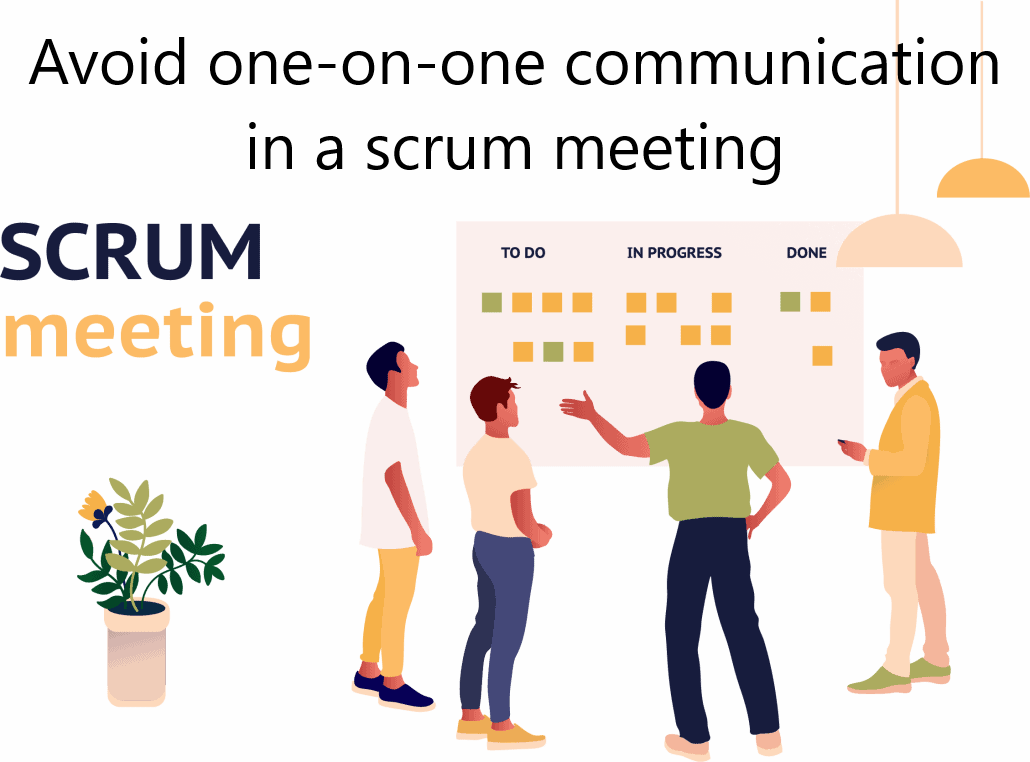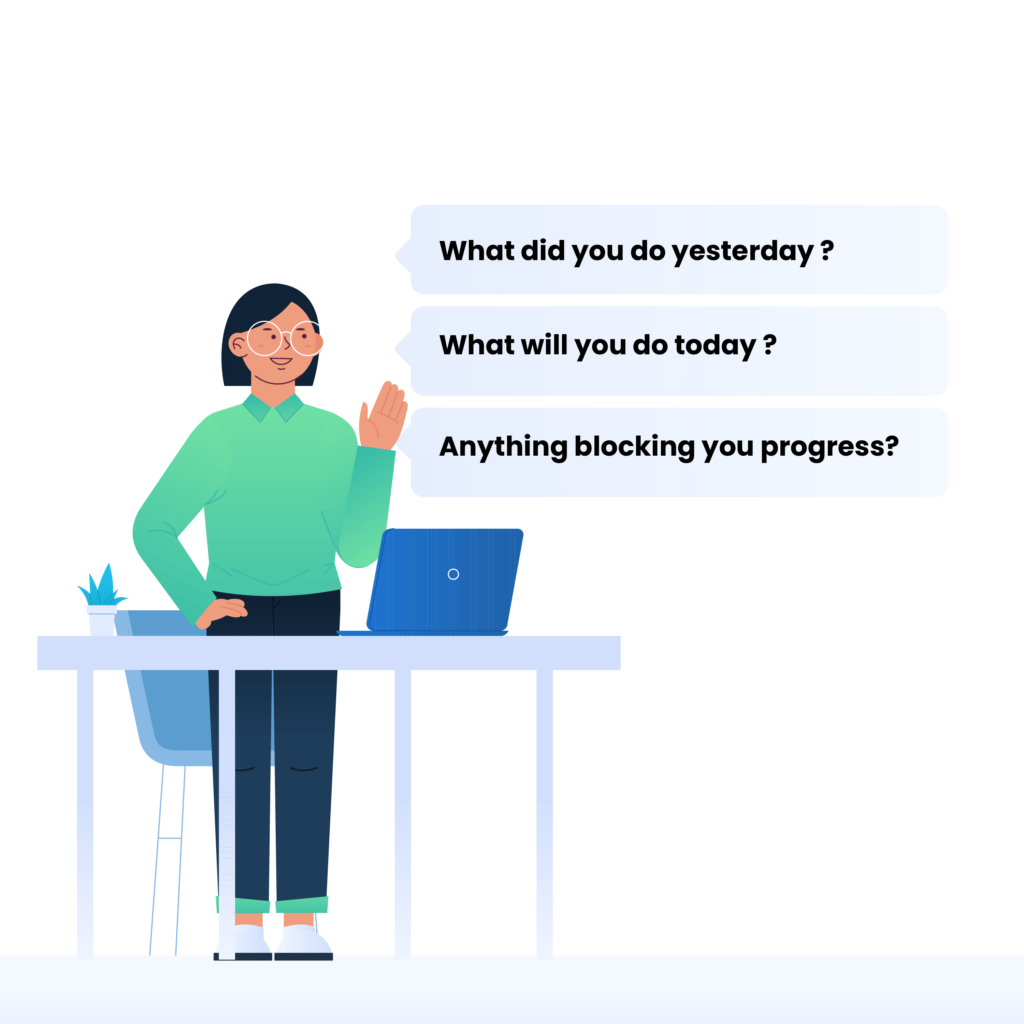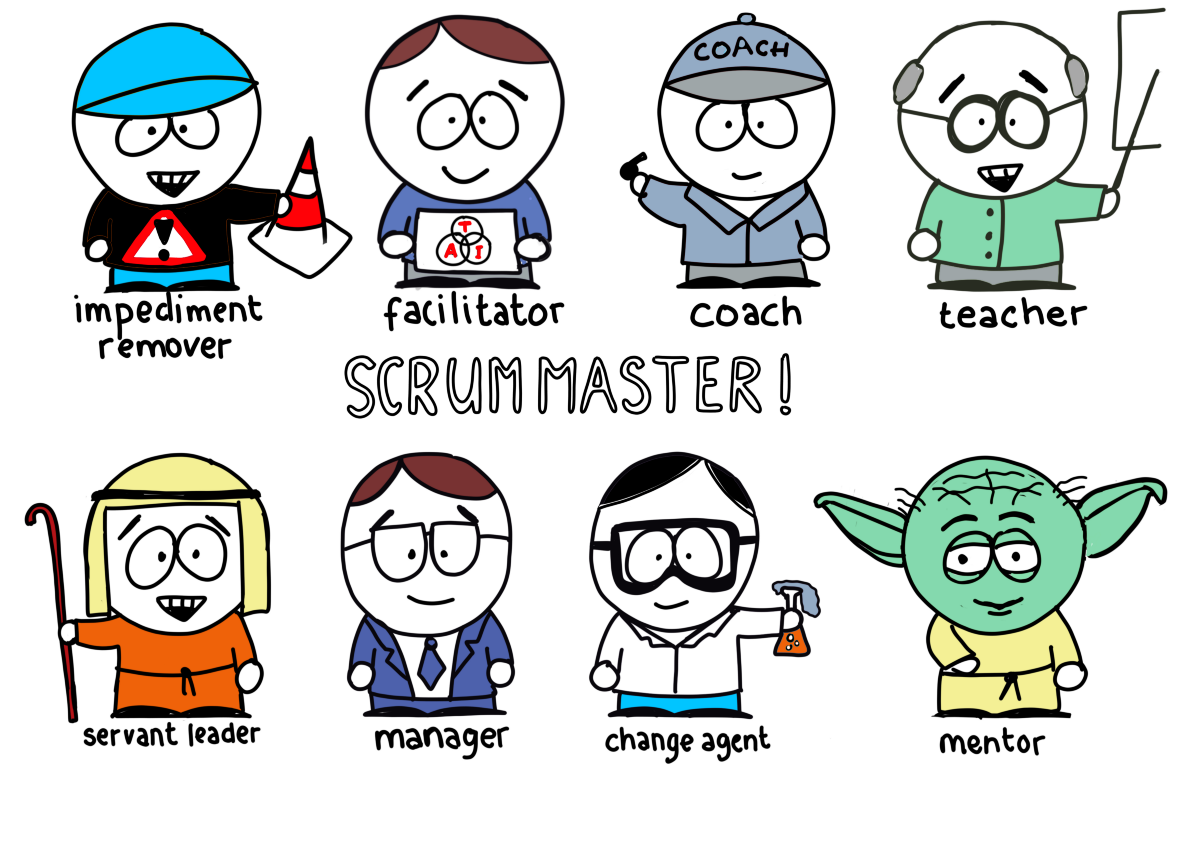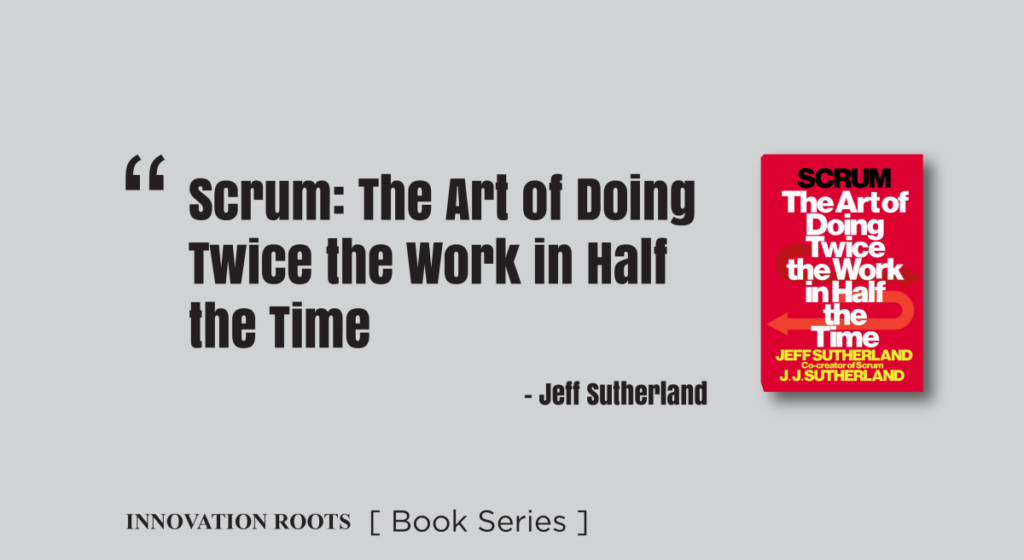The primary purpose of daily standup meetings is to align strategy with execution. Unfortunately, only a few leaders are good with this, which creates a messy situation around priorities.
Effective daily stand-up or scrum standup meetings should answer the following questions:
- What exactly should we work on?
- What is every team member working on?
- Do we know where we are headed to?
- Are people moving in the same direction?
- What is the broader strategy, and what does it look like at the task execution level?
Frequent daily standup meetings provide teams with a focused way of aligning what is happening in an organization, planning daily work, and removing blockers.

What Does Standup Meeting Mean?
A standup meeting is a short and synchronous meeting that allows team members to get together, review progress, and discuss new issues. Some organizations refer to it as a daily scrum meeting or a development team-only meeting. This meeting aims to get team members on the same page, ensuring that there is an alignment on who is doing what, what can wait versus what is a priority, and what questions and outstanding blockers need to be addressed.
Why is the Daily Standup Meeting Important?
A standup meeting is an excellent example of a daily routine that can break or improve a team’s effectiveness over time. Effective daily standup meetings empower teams with a robust framework for long-term success. On the other hand, ineffective standups can hinder a team’s ability to accomplish its goals.
How Do You Do Daily Stand-up Meetings?
Daily standup meetings agenda should be short and focus intensely on the company’s process. Every participant should arrive at a particular time; the daily scrum meetings should begin at a specific time and last 15 minutes or less.

The scum should address three cornerstone standup questions:
- What did you accomplish yesterday?
- What tasks will you perform today?
- What blockers do you face?
The answers to these standup questions should be direct and short so that every participant can respond within the short period allocated for the daily scrum meeting. The responses should be quick and concise so that the next person can also respond.
The three daily standup meeting questions help provide the purpose and structure of the meeting. The following steps can assist team leaders in ensuring that Scrum is efficient and effective.
- Keep it short: The right timing is essential in every meeting. A standup meeting should take at most 15 minutes.
- Be professional: All members should arrive on time, listen to other team members, and stand up for Scrum.
- Be valuable: All that is said in the meeting should be valuable to the majority of the participants. If you are addressing a single person or speaking about yourself, then the information may not be helpful to the other team members.
- Call “Tangent”: Every participant should have the power to call “Tangent” and end a one-on-one that is not valuable to the whole team. This will ensure there is no waste of time.
- Involve remote employees: Involving remote teams will vary based on the conference room and the scrum framework. However, it is essential to include the remote teammates through conference calls or zoom.
- Go to the source: Having some source of truth such as shared blockers, work-in-progress, and plans before a standup helps the entire team have asynchronous communication.
Further to understanding how to conduct effective standup meetings, it is critical to note the common mistakes made during these meetings. One of the most common mistakes is converting the meeting into a status meeting. It is not an overview of everything all team members intend to do.
Other common mistakes include in daily scrum meetings:

- Being late: All team members should ensure they check in on time.
- Sitting down: The scrum team should not get very comfortable. Remember the meeting should be short and snappy.
- Rambling: Scrums require agile teams that can be concise, clear, and still be mindful of the time limitations.
- Not listening:Everyone must focus because you might have a solution to another team member’s blocker.
- One-on-one conversations:Scrums are not intended for back-and-forth conversations. You must be mindful of the rest of the team.
- Repeating tasks: Teams should abstain from stating the same work items every day. It would help if you investigated why there is no progress.
- Problem-solving during scrums:Teammates should not engage in problem-solving during standups. Problem-solving requires elaborate discussions, which can be afterward.
You can avoid most of these meetings by running asynchronous scrum meetings in slack than in person.
What Is The Difference Between Daily Standup Meeting And Daily Meeting?
A daily standup meeting is meant for the development team and is led by the scrum master. It follows the Scrum methodology and seeks to answer the three standup questions. In addition, it outlines daily tasks, is short, and sticks to a specific template.
Daily meetings include more stakeholders and are more formal than standup meetings. The entire development team may be involved or only the scrum master or project manager. The meeting identifies more hindrances and engages in problem-solving. A daily meeting’s agenda is broader than a standup meeting and may discuss resource allocation.
What Should You Do Before The Daily Standup Meeting?
It is essential to plan for every standup meeting before it begins. Having the plan, shared impediments, and work-in-progress before the meeting ensures everybody is on the same page.
The host of the Scrum, typically the project manager, should meet with senior team members, the product owner, and all other stakeholders to get a status update on what’s going well and what’s not. This meeting can be monthly and will help in sprint planning during the daily standup meetings. Once the project managers understand the progress and impediments, they can allocate sprint goals and follow up on them. They can also resolve sprint backlogs quickly.
The following template will assist you in planning your meeting.

- Start time: The scrum master should set a convenient start time for everyone, including the distributed team.
- Brief physical activity: This is optional but critical in ensuring that everybody is active before they level-set their working day. Some companies embrace this, and it has proved to keep members active during meetings. However, it should take the least time possible, typically less than a minute.
- Begin: Select the first person, typically the one closest to the videoconference or joining last.
- Answer the three questions: Members should take the least time to answer the three standup questions.
- End: Close the Scrum with a cheer, team clap, or a reminder of the project’s mission.
Such a template is ideal for ensuring the startup meetings’ purpose and goals are met.
What Have You Accomplished Since The Previous Meeting?
This question is critical in a standup meeting, and every participant must answer it. It seeks to elaborate on what each team member did the previous day. If the answer to this question is similar for several days, it may indicate non-progress, and the scrum master should investigate.
Here is an example of how one might respond to the question:
What did you accomplish yesterday?
“Yesterday, I worked on developing the initial specs of ABC App project.”
What Will You Do Today?
This is also a critical question in standup questions. Team members tell the rest of the team what tasks they intend to handle on that particular day. The answer to this question will answer question one the following day.
Here is an example of how one might respond to the question:
What tasks will you perform today?
“Today, I will continue with the ABC App development project and focus on integrating it with the client’s payment options.”
What is Hindering Progress?
This is the final question in a standup meeting. It seeks to identify each team member’s blockers in the development process. However, team members should not engage in problem-solving discussions because they may be a waste of time.
Here is an example of how one might respond to the question:
What blockers do you face?
“I could need another set of eyes to test the App’s features.”

Who is A Scrum Master?
A scrum master leads a development team using agile project management skills throughout the project. They facilitate all the collaboration and communication between team members to ensure success.
The agile project management methodology applies short development cycles known as sprints to ensure continuous improvement. The scrum master must be committed to the scrum practices and values to ensure that all team members follow its framework.
Scrum Master’s Role
The key role of a scrum master is to promote team members and projects using agile project management. Depending on the work environment, a scrum master may take the roles of a project manager, facilitator, or coach.

Other duties of a scrum master include:
- Leading daily scrum meetings, demos, reviews, and other project-related meetings.
- Coaching the team members on Scrum best practices and principles.
- Supporting teams in their tasks.
- Proactively identifying and resolving blockers.
- Facilitating open discussions, problem-solving, and conflict resolution.
- Updating functions in project management tracking tools.
Scrum as a GameChanger
A Scrum Master is a servant-leader and serves the needs of his development team. He is not involved with the project deliverable’s development but prepares and organizes the team, ensuring they follow the scrum framework to deliver the project successfully. As a result, Scrum is a critical component in the successful delivery of projects.
Scrum enables teams to identify sprint backlogs and other issues addressed in sprint planning and when setting sprint goals. The scrum master reports these issues to the senior management. But the senior management is less accessible to handle the specific problems promptly. So, what does the scrum master do?
One way of quickly resolving such issues is setting up a task board of team leaders working on different projects. The task board embarks on identifying and collecting impediments, followed by a series of problem-solving discussions. Now the scrum master can escalate the matter with alternative solutions to the senior management for decision making.
Benefits of Daily Stand Up Meetings
Daily standup meetings have numerous benefits to the development team, including:
- Encourages positive team building
- Enables the team members to capture valuable knowledge
- Builds and enhances team collaboration
- Improves understanding of common goals
- Reduces impediments and blockers
The Art of Doing Twice the Work in Half the Time
Scrum’s framework, sprints, and agile working principles are applied in almost all business areas today. Scrum is basically based on a simple idea that requires you to regularly check the progress of your project and see whether it is moving in the right direction.
You should always seek to identify ways of improving what you are working on and what may hinder you from accomplishing your project. But this sounds more simple than what many corporate structures have: lengthy forms, procedures, and meetings. These structures are complex and time-consuming, unlike the visible value creation that Scrum adds.
If we genuinely want to do twice the work in half the time, we need a good understanding of the things that get in our way to productivity. Then we must also come up with quick solutions to what hinders our success. We can do twice the work in half the time by doing this.
The Takeaway from Sutherland’s Book
The key takeaways from Sutherland’s book, “The Art of Doing Twice the Work in Half the Time” are:

- Planning is useful
- Inspect and adapt. Stop what you are doing once in a while to review your progress.
- Fail fast and fix early. Corporate culture focuses on complex procedures rather than visible value creation.
- Look outwards for solutions. Complex adaptive systems learn from their environment.
- Focus on small wins. Every journey starts with a single step.
Daily Stand Up Meeting Template
Here’s a template for a typical daily standup meeting:
Date and time: Begin by stating the date and time of the meeting so that everyone is aware of when it is taking place.
Attendance: Take attendance to ensure that all team members are present.
Progress updates: Each team member should provide a brief update on their progress since the last meeting. This should include what they have accomplished, what they plan to do next, and any roadblocks they have encountered.
Issues and roadblocks: If any team member is facing issues or roadblocks, they should bring them up during the meeting so that the team can work together to find a solution.
Action items: The team should identify any action items that need to be taken and assign responsibilities to team members.
Next meeting time and place: End the meeting by reminding everyone of the time and place of the next daily standup meeting.
Conclusion
Remember, the purpose of a daily standup meeting is to keep everyone on the same page and ensure that the team is working towards the same goals. Keep the meeting short, focused, and productive, and encourage team members to actively participate and share their progress and challenges.
The agile principles of Scrum have led many businesses to adopt it. It has become so widespread that companies are now getting into Scrum-as-a-Service, an approach that puts success before everything else. Hire a SaaS product developer and start enjoying the benefits of Scrum.



